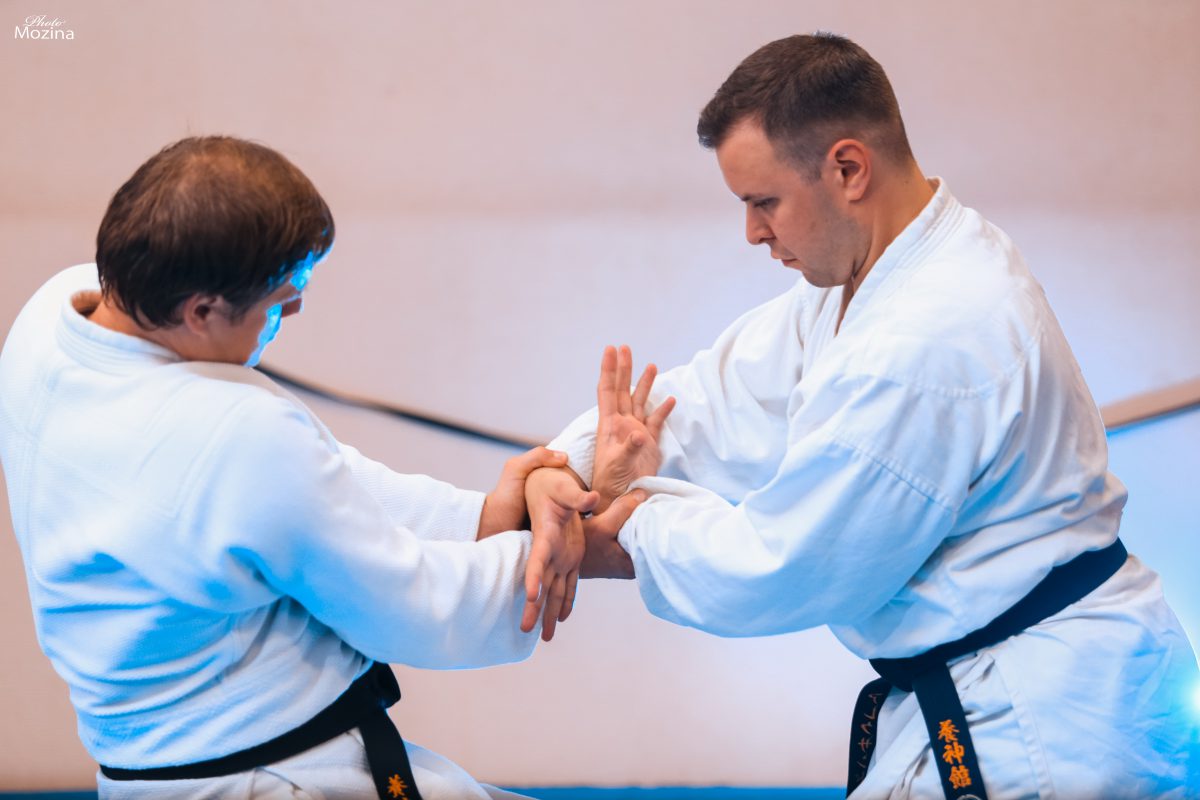Aikido Yoshinkan
Mikä Yoshinkan on?
Yoshinkan – consists of three kanji 養神館. These kanji can be translated as “Hall of Spirit Cultivation”.
The founder Gozo Shioda named his dojo “Yoshinkan” after a dojo of the same name that was built by his father, a physician, who wanted to improve both physical and spiritual health.
Gozo Shioda did Aikido as Morihei Ueshiba’s Uchi Deshi from 1932 to 1941 years.
After The Second World War, Ueshiba’s Aikido changed because of Omotoke religion that influenced his Aikido. It became softer and lost its former power.
The founder Gozo Shioda ran their own school where he kept techniques and teaching the method similar to the pre-war Aikido taught by Morihei Ueshiba.
As style of Aikido, Yoshinkan arose in 1955.
Started from 1957 the “Senshusei” course to Tokyo Police Department was founded. This course became compulsory for people who want to be a policeman.
Since 1990 this course can be done by everybody who wants to be an Yoshinkan Aikido instructor and provide Yoshinkan in other countries.
Now the Yoshinkan Aikido is currently the second largest aikido organization worldwide.
Yoshinkan Aikido is represented by The Yoshinkan Aikido Honbu Dojo and Yoshinkan Aikido Foundation.
You can see more about YAF here.
Difference Yoshinkan from other styles of Aikido
Yoshinkan is unlike other styles Aikido like: Aikikai, Ki-Aikido or Real Aikido.
Yoshinkan uses the combination of 6 basic techniques which are known as Kihon Dosa.
People can do them on their own or with a partner and with or without traditional Japanese weapons.
The Main goal of Kihon Dosa is to improve basic techniques and develop internal forces of a body. This is the basis of all Yoshinkan techniques.
Now Yoshinkan Aikido has some 150 Khon Waza which are practised repeatedly and designed to teach principles of movement, balance, timing, etc. The main difference from other Aikido styles is that each technique is divided into several parts which are done separately.
The current method of breaking the techniques into steps and the Kihon Dosa has decreased the study a lot of people in a short period of time.
The Structure of Yoshinkan lessons
Taiso that means warming up. This set of standard of exercises is used to prepare a body for training to avoid injures.
The Kihon Dosa – this set used in the second part of a lesson to develop basic techniques.
Beginners do the Kihon Dosa without a partner to improve their movements and postures.
However Advanced students usually do this set with a partner to improve their skills and manage to control their partners.
Ukemi Waza is a set of basic techniques to develop safety falls. This includes some rolls forth and back.
Kihon Waza is a basic set of techniques done with a partner to improve skills and the capability of controlling them.
Oyo Waza is a set of techniques done as one movement continuously.
Jiyuwaza is a set of techniques done continuously and combat from any attacks.
Yoshinkan is no a fighting system. There is no sparring as in boxing or kumite in karate. Therefore, people can do this Aikido style safely.
The Uniform of Yoshinkan
There are the same rules as in other styles of Japanese martial arts.
Yoshinkan uniform consists of:
Dogi is a jacket and pants. This Dogi should be white.
Obi – a belt. belt colors depend on the level of a student.
Adult students from the 10th to 4th Kyu wear white belts.
Adult student from the 3rd until 1st Kyu wear brown belts.
Adults with master degree from Shodan and above wear black belts. From the 3rd dan they can wear Hakama – traditional Japanese pants. They can be black or navy-blue colors.
The Belt system in children’s group is a little different.
There aren’t any strict rules, everything depends on Dojo.
In the YukimuraKan Dojo there is the system is the following
The 10th-7th Kyu – white belt. When students pass exam on 8 Kyu they have to wear the Dojo’s logo on their belts or Jackets.
The 6th Kyu – yellow color of belt
The 5th Kyu – red color of belt
The 4th Kyu – orange color of belt
The 3rd Kyu – green color of belt
The 2nd Kyu – blue color of belt
The 1st Kyu – brown color of belt
Buki classes
Yoshinkan is the same as other Aikido styles which use traditional weapons. There is boken. It is a wooden Japanese sword. Jo is a wooden stick 1.3m in length.
Tanto is a traditional wooden knife.
Exam system
As Yoshinkan isn’t a fighting martial art, there is no sparring. This style uses a special exam system to control the progress students made in their Aikido path. Exams are done according to the program of the Yoshinkan Aikido Honbu Dojo.
More information about exams you can see here…
Yoshinkan Aikido is a perfectly balanced and harmonious martial art. It combines stiffness and softness, strength and relaxation, focus and expansion. This is a great way to achieve harmony, peace and tranquility in yourself and spread this to those with whom we are connected.
The techniques of Yoshinkan are tools to discipline a body and to strength the spirit.
The most important purpose of Yoshinkan is to learn how people improve themselves.

